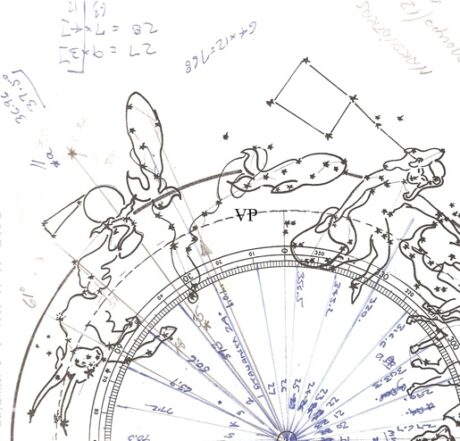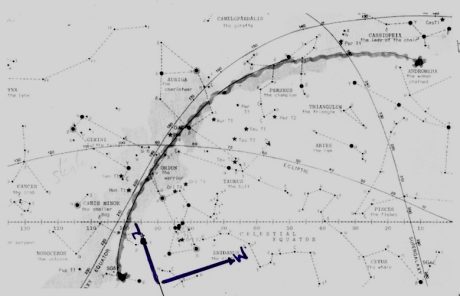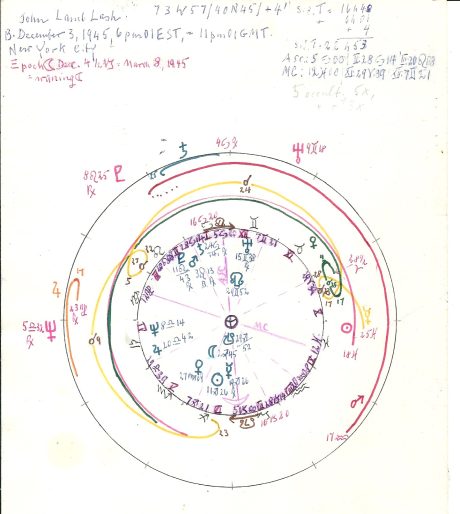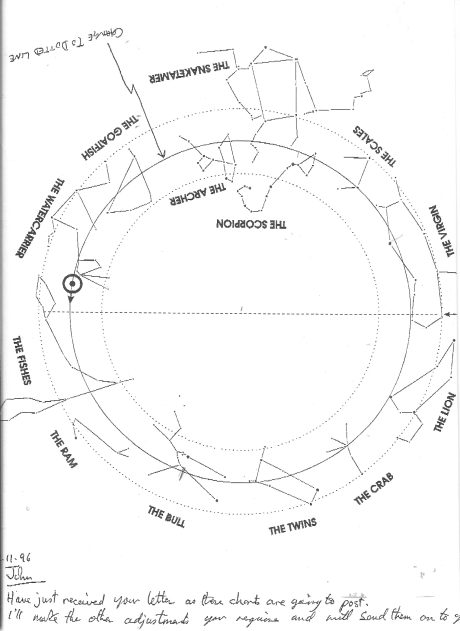The Great Runic Script
A singular light burns in his glances when the great runic script lies before us, and he stares into our eyes to see whether within us also has arisen the constellation which will make the figure of life-itself visible and comprehensible.
Novalis (Friedrich von Hardenberg, 1772 – 1801), Fragments, circa 1790
The Art and Method of Forensic Astronomy
An Illustrated Review

One example of the hundreds of workups I did for the Rimsite.
Backstory
I don’t know if I can determine when the vision of Celestics emerged in my imagination for the first time. I remember looking at Orion from a perch in the apple tree in the yard of my home in Friendship, Maine. I was about ten years old. That constellation is, of course, one of the most recognizable in the sky. Little did I know that my rigpa was directing to M 42, the Orion Nebula, where the genomic template of the Anthropos is embedded.
In March 1966, as I sat by lake Pewa Tal in Pokhara looking again at Orion, I witnessed an inexplicable event in the sky. I noticed a star to the left of Orion. It was huge and bright. It appeared to be Sirius but oddly seemed like a duplicate or twin of it, flashing and wobbling in an erratic way. I distinctly recall that I had to concentrate to check if was seeing double. I was not sure if it was Sirius or a different star similar and close to it – which made no sense. I thought, “That star looks like it wants to tear itself away from its position,” and then it did just that. It moved as if staggering under tremendous weight upward and to the west, arching high into the north-west and then hovering at a point due north, right over Annapurna. I was totally astonished. The spectacle registered in my mind with the meme, “Northern Star.”
The omen played out later when I was in Madras and I met a stranger at the post office. We met again — an enigmatic supernatural incident I have described elsewhere — when I confessed in desperation that I did not want to die in India, that I had to find some way to get out of there. He advised me to go to the port and look for a ship called “Northern Star.” He said it was waiting for me and I could go aboard and take safe passage.
Sketch of the track of the moving star I saw in March, 1966. I believe I was looking south-west when it began. I had to get up from the stoop of the small building (now the tourist office) where I was sitting and go around it to the right to follow the complete trajectory. The wavy line suggests the way it seemed to stagger under a heavy burden. Its trajectory was not smooth and even. In retrospect, it is remarkable how it travelled between the Twins and the Bull, across Auriga (Grail King) and Perseus (Andromeda myth) and reached Andromeda. All these figures participate strongly in the mythos I later developed. It settled near Andromeda, low over Annapurna, north-west of Pokhara.

So, what came next? Upon returning from Asia that year I lived in the Lower East Side of NYC at 144 Avenue B. That’s when I bought my first book on astrology. Having been inspired at sixteen by Fred Hoyle’s book, Frontiers of Astronomy, I expected to find star lore in the study of astrology. Of course, I found none. I pursued astrology as a follow-up to my keen interest, and skill, in mathematics. The first charts I cast, calculating by hand, where those of Jan Kerouac and myself. That was in January 1969, three years later. I was baffled by the absence of any stars in the format.
Here the timeline becomes jumbled. I recall clearly during my first period in Santa Fe, July 1972 to April 1974, that there was a print shop on Canyon Road near where I was house sitting for my friend Mary Palevsky, niece of Max Palevsky who owned Xerox. I had a set of four colored formats printed, including an early model of the Rimsite in blue, which I cut out and positioned around the sign-frame. That means I must have developed the Rimsite in the early 1970s, more than 50 years ago. It baffles me how I could have done that! Nevertheless, I must have been using it when I did charts in Santa Fe during that period, like this one:

My “quest for the zodiac” continued intensively in Los Angeles in September of 1974. By then, I was working with the juxtaposition of sign/constellation, but I was not satisfied with the workmanship of the format. One fine day, I went to the local branch of the LA library on Cahuenga near Hollywood and Vine and sought out the astronomy section. I was intent on a single purpose: to find a star map of the constellations missing from the astrological format of signs and houses. I found a fair number of star atlases and skywatching guides for all seasons, but I did not find what I really needed. All the maps and viewing guides showed the surrounding heavens in cut-out sections seen from different perspectives at different times of the year. It was like finding parts of a human body, head, torso, limbs, but no intact model. I felt like Isis trying to retrieve and assemble the parts of the dismembered body of Osiris.
Astrosophy
That same year I met Willi Sucher, the founder of Astrosophy, and read his work on both signs and constellations. He cast my natal chart by his method (geocentric, below), using the conventional glyph for Cancer for the region of the Twins.

Sucher’s handwritten version of my natal pattern
To this day, I am unclear how Sucher used signs and constellations in distinction, or how he indicated them in his format. Note Saturn at the top showing the unusual loop it made through the Twins in the period from epoch (prenatal or conception chart, 18 March 1945) to birth. That loop occurred in the Twins between the perihelion of Saturn and its north node, but Sucher noted it with the astrological symbol for Cancer.
Working with Sucher, I was gathering a lot of sky-lore, but I still did not have the master template that was to become the Rimsite. That changed in 1981 when I returned to New Mexico. There I spent hours under the magnificent night sky seen from the llano above my house at La Vereda. Taking my cue from the Jupiter-Saturn conjunction in the Virgin (July 18, 1981 @ 185° at 5 Libra), closely aligned to Vindemiatrix, the Grail cup, I presented “The Course” with a set of lessons dedicated to “Terrastrology.” At the same time, I reworked the Rimsite for more accuracy and graphic exactness.

There was some construction on the compound at La Vereda and workers had left behind an empty wooden spool for storing cable of some kind. I hauled it into my studio. The diameter was about four feet. I cut out and glued sections of heavy drawing paper around it and proceeded to plot the constellations by degrees, then added the graphics. Later I had someone construct a movable wheel for me using another version of the proto-Rimsite. I used this wheel in classes. It clearly showed the starless sign format within and the environing stars without. It was designed so that I could rotate the Rimsite around the sign-frame to illustrate the precession of the equinoxes.
Formatting the Rimsite
Fine, that was progress. But it was not until 1996 that I got my first version of the Rimsite in IT format. While writing articles on the real-sky Zodiac for a UK mag on astrology, I met someone in Cambridge who did the conversion, dated 22/11/96.

I traced this model for more accurate positions of stars in the graphics. Believe it or not, it was not until 2015 that student-friends in Spain undertook the task of developing the StarBase software in the code room of Celestics.org today. StarBase 5.0, generates the Rimsite with astronomical and descriptive data for manifolds.
Celestics.Org
The name Celestics came to me on January 14, 2014 when completing the GNE. It came entirely out of the blue. I still had three months to go with the GNE and I did not expect an entirely new program to emerge. That sudden hit produced a dozen or so talks with text and illustrations that I posted on metahistory.org. Fast forward 22 months and the Celestics Training Course was underway. You can find it now in ‘Original Release’ block and two other blocks below.
With the premiere of Celestics.org in May 2025, I have revised this landing page and I am set to reorganize some of the blocks and units in the menu panel. I need to avoid rewriting for Celestics.org what I have already written here on Nemeta. The interface of the two platforms raises an issue for me concerning revision. Material on Celestics.org will be new even though I draw some of it from previous writings on the zodiac, both published (hundreds of pages) and unpublished (hundreds more). Revision is a bitch and she so loves to torment me. Quest for the Zodiac, for example. Life is too short to revise and write originally in the same breath. I am looking hard at how to sort that one out.
With the release of Celestics.org in May 2025, Nemeta has a sister platform that reprises material originally posted here in an improved and expanded presentation. This project is the completion of 50 years of research, consultation, and experimentation with the star-based code of the real-sky zodiac. The image above is one of the hundreds of working drafts it took to establish the Rimsite of the zodiac with astronomical exactness for the graphics of the 16 constellations on the ecliptic rim. The full array includes the unique area absent of distinctive stars between the Archer and the Goatfish, the Great Void. There are 13 major figures in the display.
Over time, I added two minor or ancillary figures, the Celestial Anchor and the Cache, or Treasure Chest, as well as seven marginal areas: the Heart of the Bull, the Milky Way between Bull and Twins (direction opposite the galactic center), the Dhumavati Points, the Rishi Zone, the Correction Zone, the tail of the Goatfish, and the Matangi Point in the cold currents under the Western Whale. The Rimsite is a work in progress. The current working model needs some find adjustments in longitudes and graphic details. The hand-drawn figures could be improved at some points. This task requires expertise with tools of design that I cannot manage on my own.
I encourage everyone who takes an interest in Celestics to engage in hands-on work with the constellational imagery, plotting your own Rimsite with colored lines for the various entries, tracing the figures and researching the rich legacy of constellational art, such as Pegasus in the header image. I also advise that you combine these practices with active Skywatching (Course 11) and observation of the lunar cycles.
Nemeta does not a the moment (December 2025) offer individual versions of of StarBase manifolds, but Celestics will eventually do so with the Sampler. (Inquire at mail@celestics.org.) Nemeta will make special provisions for supporting members who would like to access this material. Arrangements will be announced on The Dolmen.
A revision of Quest for the Zodiac (2000) is long overdue. That book is out of print. The version that can be found for sale (at no profit to myself) on the internet does not adequately or accurately represent the form Celestics has now taken. It has serious flaws and some downright silly assertions, and much of it can be disregarded as a rough work that does not stand up so well 23 years later. The revised edition will be on sale at Celestics.org in a POD version.
14 Celestics: Course Curriculum
- § HIGHLIGHTS AND PREVIEWS
- 14 Celestics: What’s In It For You
- *CELESTICS CAMEOS
- 14 My Hollywood Valentine
- Private: 14 Sabina Speilrein
- 14.100 REAL-SKY PARABLES
- 14 The Thrice Beautiful Mahavidya
- 14 100 The Parable of the Scales
- 14.100 The Parable of the Cache
- 14 Mythography of the WHALES
- 14.101 A PRIMER OF STAR BASE
- 14.101 In the Dark of the Night
- 14.101 Astrology Without Stars
- 14.101 Visions on the Rimsite
- 14.101 Cycles of Animations
- Private: 14 In the Galactic View
- 14.102 THE FIVE GREAT TABLEAUX
- 14.100 The Five Great Celestial Tableaux (Stories in the Sky)
- Private: 14.100 ONE The Bodhisattva Tableau
- Private: 14.100 TWO The Correction Tableau
- Private: 14.100 THREE The Andromeda Tableau
- Private: 14.100 FOUR The Navigator Tableau
- Private: 14.100 FIVE The Braveheart Tableau
- 14 ORIGINAL RELEASE METAHISTORY 2014
- Private: 14.101 The Art of Forensic Astronomy 1
- 14.102 2014 Forensic Astronomy Talks 1 – 4
- 14.102 Forensic Astronomy 5 – 8
- 14.102 Forensic Astronomy 9 – 12
- 14 CTC CELESTICS TRAINING COURSE
- 14 CTC Materia Mythica 1
- 14 CTC Materia Mythica II
- Private: 14.100 Celestics
- Private: 14.100 Celestics II
- 14 CTC Lesson 1: The Truth On Which You Stand
- 14 CTC Lesson 2: Identity Versus Character
- 14 CTC Lesson 3: Adaptation and Relearning
- 14 CTC Lesson 4: The Vector of Genius
- 14 CTC Lesson 5: The Rule of Psyche
- CTC Lesson 6: Mythopoesis and Individuation
- Private: 14 CTC Lesson 7: Mercury and Venus
- Private: 14 CTC Lesson 8: Struggle Against the Social Order
- Private: 14 CTC Lesson 9: The Ascendant and the Riddle of Addiction
- Private: 14 CTC Lesson 10: The Social and Cultural Currency of Star Base
- 14 CTC LESSON TRANSCRIPTIONS
- CTC Lesson 1 The Truth on Which You Stand Transcription
- CTC Lesson 2: Identity Versus Character Transcription
- CTC Lesson 2: Addendum Transcription
- CTC Lesson 3: Quandaries of Adaptation and Self-Ordering Transcription
- CTC Lesson 4: The Vectors of Genius Transcription
- CTC Lesson 5: The Rule of Psyche Transcription
- CTC Original 6: Mythopoesis and Individuation Transcription
- Private: CTC Lesson 7: Mercury and Venus Transcription
- Private: CTC Lesson 8: Struggle Against the Social Order Transcription
- Private: CTC Lesson 9: The Ascendant and the Riddle of Addiction Transcription
- Private: CTC Lesson 10: The Social and Cultural Currency of StarBase Transcription